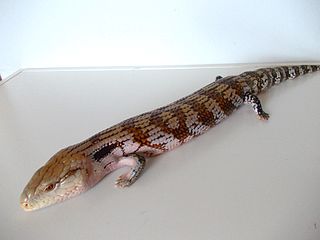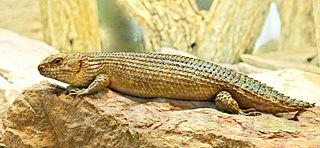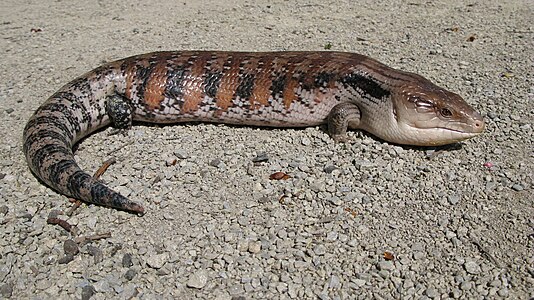
Skinks are lizards belonging to the family Scincidae, a family in the infraorder Scincomorpha. With more than 1,500 described species across 100 different taxonomic genera, the family Scincidae is one of the most diverse families of lizards. Skinks are characterized by their smaller legs in comparison to typical lizards and are found in different habitats except arctic and subarctic regions.

The Solomon Islands skink, also known as prehensile-tailed skink, monkey-tailed skink, giant skink, zebra skink, and monkey skink, is an arboreal species of skink endemic to the Solomon Islands archipelago. It is the largest known extant species of skink.

The pink-tongued skink is a species of lizard in the family Scincidae. C. gerrardii is endemic to Australia, where it is also called commonly the pink-tongued lizard. As suggested by these common names, its distinguishing characteristic is a pink tongue as opposed to the blue tongue of lizards of the closely related genus Tiliqua.

The western skink is a species of small, smooth-scaled lizard with relatively small limbs. It measures about 100 to 210 mm in total length. It is one of seven species of lizards in Canada. They spend much of their day basking in the sun. Their diet ranges widely, including spiders and beetles. Western skinks will bite if grasped and will flee if they feel threatened. It is a common but secretive species whose range extends from southern British Columbia and throughout Washington, Oregon, Nevada, Utah, Idaho, and Wyoming and into western Montana and northern Arizona and Missouri. They can also live in some areas of Texas It is widespread in northern California but primarily restricted to the coast in central and southern California. Found in a variety of habitats, this lizard is most common in early successional stages or open areas of late successional stages. Heavy brush and densely forested areas are generally avoided. Western skinks are found from sea level to at least 2,130 m (7,000 ft). This diurnal reptile is active during the warm seasons.

The prairie skink is a species of skink endemic to the prairies east of the Rocky Mountains in North America. It is one of only seven species of lizards that occur in Canada.

The Bermuda skink, longnose skink, or Bermuda rock lizard is a critically endangered species and the only endemic land-living vertebrate of Bermuda. It is a relatively small skink : adults reach an average snout-to-vent length of about 8 cm (3.1 in).

The viviparous lizard, or common lizard,, is a Eurasian lizard. It lives farther north than any other species of non-marine reptile, and is named for the fact that it is viviparous, meaning it gives birth to live young. Both "Zootoca" and "vivipara" mean "live birth," in Greek and Latin respectively. It was called Lacerta vivipara until the genus Lacerta was split into nine genera in 2007 by Arnold, Arribas & Carranza.

Blue-tongued skinks comprise the Australasian genus Tiliqua, which contains some of the largest members of the skink family (Scincidae). They are commonly called blue-tongued lizards or simply blue-tongues or blueys in Australia. As suggested by these common names, a prominent characteristic of the genus is a large blue tongue that can be bared as bluff-warning to potential enemies. The type of predator/threat that is near will determine the intensity of colour present in the tongue. The tongue can also deform itself and produce a thick mucus in order to catch prey. They are relatively shy in comparison with other lizards, and also significantly slower due to their shorter legs.

The blotched blue-tongued lizard, also known as the southern blue-tongued lizard or blotched blue-tongued skink is a blue-tongued skink endemic to south-eastern Australia.

Tiliqua rugosa, most commonly known as the shingleback skink or bobtail lizard, is a short-tailed, slow-moving species of blue-tongued skink endemic to Australia. It is commonly known as the shingleback or sleepy lizard. Three of its four recognised subspecies are found in Western Australia, where the bobtail name is most frequently used. The fourth subspecies, T. rugosa asper, is the only one native to eastern Australia, where it goes by the common name of the eastern shingleback.

The Tiliqua scincoides scincoides, or eastern blue-tongued lizard, is native to Australia. It is unique due to its blue tongue, which can be used to warn off predators. In addition to flashing its blue tongue, the skink hisses and puffs up its chest to assert dominance and appear bigger when in the presence of its predators such as large snakes and birds. The eastern blue tongue is ovoviviparous and precocial, meaning that its young are more developed and advanced at their time of birth. The Tiliqua scincoides scincoides is not venomous to humans and can be found in suburban and urban areas, specifically in house gardens.

Cunningham's spiny-tailed skink, also known commonly as Cunningham's skink, is a species of large skink, a lizard in the family Scincidae. The species is native to southeastern Australia.

The western blue-tongued lizard, also known as the western blue-tongued skink, is a large skink native to Australia. It is one of six species of blue-tongued skinks found in Australia, though further species are found in New Guinea and Indonesia.
Intermedia, Latin for "across multiple channels", is a concept in the arts.

The Irian Jaya blue tongue skink is one of the least understood species of blue-tongued skink. The Irian Jaya has yet to be scientifically classified, but is arguably a different species from the other recognized members of the genus.

The Indonesian blue-tongued skink is a lizard in the family Scincidae. It is a close relative of the Eastern blue-tongued lizard. They are endemic to the island of New Guinea and other various surrounding islands. They are found typically in the rainforest, and in captivity, require high humidity. As opposed to Tiliqua scincoides, they are fairly lean. They're also accompanied by long tails.

Tiliqua scincoides is a species of skink. It is native to Australia as well Tanimbar Island.

The Centralian blue-tongued skink or Centralian blue-tongue is a species of skink, occurring predominantly in the far north-west corner of New South Wales, Australia. It is one of six species belonging to the genus Tiliqua; the blue-tongued skinks and the shinglebacks.

Egernia stokesii is a gregarious species of lizard of the Scincidae family. This diurnal species is endemic to Australia, and is also known as the Gidgee skink, spiny-tailed skink, Stokes's skink and Stokes's egernia. The species forms stable, long-term social aggregations, much like the social groups seen in mammalian and avian species. This characteristic is rarely found in the Squamata order, but is widespread within the Australian subfamily of Egerniinae skinks. Populations of E. stokesii are widely distributed, but fragmented, and occur in semi-arid environments. There are three recognised subspecies. The conservation status for the species is listed as least concern, however, one subspecies is listed as endangered.

The black rock skink is a species of large skink native to Eastern and Southern Australia from central New South Wales to Grampians National Park in Victoria. A large, dark colored skink, up to 135 mm from snout to base of the tail, the black rock skink is the first reptile discovered to have a "nuclear family" structure where the parents form a pair and care for their offspring for more than one year. The black rock skink is a viviparous skink meaning females give birth to live offspring instead of laying eggs. They defend their home range and families against conspecifics for up to several years.




















